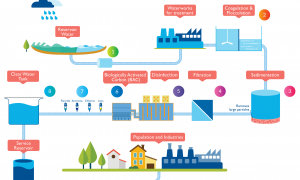🕑 Reading time: 1 minute
There are number of factors that affect embankment dam design. That is why the designer needs to take these factors into consideration during the design. These factors will be discussed briefly in the following sections.Factors Affecting Design and Construction of Embankment Dams
- Availability of materials for construction
- Characteristics of embankment dam site
- Shape and size of valley in which the dam is constructed
- Climate of the area
- Diversion of river
- Time available for construction
- Function of the reservoir
- Probable wave action
- Earthquake activity in the area

Availability of Materials for Dam Construction
Commonly, construction materials for embankment dams are widely available and often can be obtained at or close to construction site at low cost.
Fig.1: Using different types of material for dam construction
Type of material at available at construction site would influence the embankment dam design. Table 1 provides type of dam designed based on the available materials. The economy of construction can be improved by using excavated material in the construction for instance earth excavated for spillway construction. Table-1: Embankment dam designed and constructed based on the available construction material| Type of material available at project site | Designed embankment dam based on available construction material |
| Impervious soil material | Homogeneous embankment dam, figure 2 |
| Rock and impervious material | Rock fill dam, figure 3 |
| Previous and Impervious material | Zoned earth dam, Figure 4 |

Fig.2: Homogeneous Embankment Dam

Fig.3: Rock Fill Embankment Dam

Fig.4: Zoned Earth Dam
Characteristics of Embankment Dam Site
Generally, embankment dams can be constructed on nearly all kinds of soil. The properties of soil on which the dam is constructed affect the design considerably. One of the outstanding affect is controlling the type of treatment used for the foundation. Moreover, soil properties influence the dimension of the dam for instance if the soil has low bearing capacity, then it would be necessary to reduce slopes, use greater cross section and freeboard. These measures are required to tackle deferential settlement of the embankment dam.
Fig.5: Embankment Dam Site, Compaction of Soil Foundation
Shape and Size of Valley in which Dam is Constructed
If the valley on which embankment dam is constructed is narrow and has abutments with steep slopes, then embankment design would be influenced. In this case, construction space would be limited and subsequently a simpler design, which may need special construction provision, shall be used. As far as wide valley with low abutment slopes will not affect the design.
Fig.6: Embankment dam constructed in a narrow valley

Fig.7: Embankment dam in open area
Climate of the Area
Generally, climate of the region will influence the embankment design. For example it is recommended to use sloped core for the dam if the construction is carried out during rainy season. Added to that, when embankment dam is constructed in arid area, then one more year might be required to collect water and begin the construction. This because the construction moisture content of fine grain soil in this area cannot be controlled.Diversion of River
Diversion of river is another factor that affects the design of the dam. For narrow valley, the river is diverted through tunnels.
Fig.8: River diversion through tunnel, left side inlet of the tunnel, right side is the path of the tunnel on each side of the river
In this case, the designer shall study all possible cases of river diversion and arrange his/her design with diversion river options. When the embankment dam is built on major river, then each side of the dam would constructed from abutments and the central portion of the dam will be left and used as diversion river.
Fig.9: River is allowed from one side of the valley and construction of the dam starts from the other side of the valley
This part of the dam, which is called closure section, is constructed at the final stage of dam construction. The closure section should be constructed rapidly so as to prevent the overtopping of the dam. So, special design and construction measured should be used for closure section for example introducing extra drain filter.Time Available for Construction
Time allocated for embankment dam construction is another factor that its design is based on. If the height of the dam is considerable and the dam needed to be constructed in short time, then higher pore water pressure is likely. Consequently, flatter slope should be considered for the dam to tackle the pore water pressure. It should be known that, fine grain soil requires long time to be dealt with, so if construction time is restricted, produced impervious layer should be installed to save time.Function of the Reservoir
The function of the reservoir specified the permissible water loss due to seepage thorough foundation and embankment. Subsequently, the design of the dam would be affected. For example, if the dam is used water conservation, then the dam should be impervious whereas more previous dams are accepted for flood control purposes.Probable Wave Action
Reservoir length and wind velocity control wave action seriousness and the degree of protection needed for the upstream of the dam. Upstream face of the dam experience erosion due to cyclic wave action unless proper protection measure is considered for the upstream of the dam. It is reported that, cover upstream with layer of dumped rock is not only an effective protector but also considerably cost effective.
Fig.10: Embankment dam with rock facing provided to protect upstream from wave action


